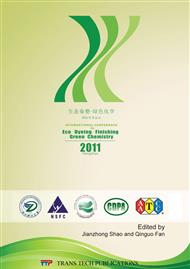p.132
p.138
p.145
p.150
p.155
p.160
p.165
p.169
p.174
Dyeing of Silk with Natural Plant Extract from Rhizoma picrorhizae
Abstract:
A new concept that uses natural plant extract from Rhizoma Picrorhizae (RP) as a natural dye in silk dyeing was proposed. The RP extract can be adsorbed by silk to provide yellow to brown color, depending on the RP concentration. The stabilities of RP solution against pH, heat, and ultraviolet light were investigated. Factors such as pH, temperature, dyeing time, RP concentration were studied in order to understand the dyeing properties of RP extract for silk fabric. After dyeing, some of the samples are mordanted with different mordants. It was founded that RP extract was stable at acidic conditions and stable to heat and ultraviolet light, and the interactions between silk and RP extract molecules were non-electrostatic interactions; and that RP extract showed good building-up properties on silk. Furthermore, the colors of the dyed fabric mordanted with different mordants as well as their depth were greatly dependent on the chemical nature of mordants. In conclusion, RP was a potential natural dye which can be applied to silk dyeing.
Info:
Periodical:
Pages:
155-159
Citation:
Online since:
January 2012
Authors:
Keywords:
Price:
Сopyright:
© 2012 Trans Tech Publications Ltd. All Rights Reserved
Share:
Citation:


